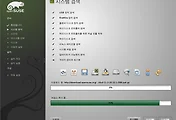 Think different. by funadium |
막혀서 위키를 봤는데.. 역시 위키는.. ㅋㅋㅋ emerge에서 mask가 떠서... 아 젠투도 볼께 많구나..
출처는 :: http://boinc.berkeley.edu/wiki/Installing_BOINC_on_Gentoo
Basic installation
Installs BOINC Client as a daemon (autostarts the BOINC client at boot time) and puts a BOINC Manager icon on the "Start Menu" if you have a GUI Desktop installed. Open a terminal and become root. Then enter the following commands:
| BOINC is currently masked
in Portage. The first command will allow you to bypass the mask |
-
echo "sci-misc/boinc" >> /etc/portage/package.keywords -
emerge --sync -
emerge sci-misc/boinc - Optional: after the installation is finished, enter
rc-update add boinc defaultto have Linux auto-start the boinc-client daemon at boot time. (See Stop or start BOINC daemon after boot page for helpful commands for managing the daemon)
What the installer does
- Creates the daemon script at /etc/init.d/boinc
- Creates the daemon script configuration file at /etc/conf.d/boinc.
- Puts the BOINC binaries (boinc_client, boinc_cmd and boincmgr) in /usr/bin/boinc
- Creates /var/lib/boinc/ for BOINC data files and the slots and projects directories.
- Names the daemon
boinc - Creates a user named boinc. For security, boinc owns the BOINC data directory (/var/lib/boinc/) and all the data files and sub-directories it creates in the data directory.
Verify the installation
- Start the daemon with
/etc/init.d/boinc start - Open a terminal and enter
ps aux | grep boincto print a partial list of running processes. You should seeboinc_clientin that list, if not then something went wrong in the steps above.
Set up your accounts
To use the GUI to set up your accounts and monitor progress:
- Start "boincmgr" on the command line or select Applications -> System Tools -> Boinc Manager from the GNOME menu.
- Select Advanced -> Select computer... from the Boinc Manager menu.
- Put "localhost" in for "Host name" and the contents of /var/lib/boinc/gui_rpc_auth.cfg for "Password" and hit "OK".
To make the GUI passwordless instead, do "echo > /var/lib/boinc/gui_rpc_auth.cfg" (which replaces the contents of the file with a newline) and then restart boinc-client (with e.g. "/etc/init.d/boinc restart").
Alternatively, you can use the command-line interface to set up your accounts. See "man boinc_cmd" for instructions.
Optional setup hints
For more information about configuring BOINC in Linux, see Linux file permissions
| It has been suggested that this section be split into a new page. (Discuss) |
If you do only the basic installation as described above, BOINC manager
will not be able to automatically connect to the client. To connect the
client you will be required to give the GUI RPC password every time
you start BOINC manager. That is not a bug, it is a security feature to
prevent other users from using the manager to manipulate the client,
changing your projects, etc. Another inconvenience is that boinc (the
user named boinc) owns /var/lib/boinc/ and all the files and directories
in it so you will not be able to edit those files from your regular
user account unless you add your username to the boinc group and adjust
some permissions as follows, substituting your username for
<username>:
- As root, open /etc/group in a text editor.
- Look for the line starting with boinc:x:<group ID number>:
- Edit the line to look like
boinc:x:<group ID number>:<username>(<group ID number> will be a number, do not change it) - Save the file and close the editor.
All the above can be done by: (sudo) gpasswd -a <username> boinc
- Open a terminal as root and enter the following commands,
substitude your username for <username>:
-
ln -s /var/lib/boinc/gui_rpc_auth.cfg /home/<username>/gui_rpc_auth.cfg -
chown boinc:boinc /home/<username>/gui_rpc_auth.cfg -
chown boinc:boinc /var/lib/boinc/gui_rpc_auth.cfg -
chmod -R g+r /var/lib/boinc
-
Uninstallation
As root, in a terminal, enter
emerge -C sci-misc/boinc
'Study > Linux' 카테고리의 다른 글
| Vmware로 리눅스 커널 업데이트시 VFS 등 Sda2 실패할때, 또는 Make install 이 안될때. (4) | 2010.04.29 |
|---|---|
| What does it mean when a package is masked? (0) | 2010.04.14 |
| 와우, 오픈 수세,,, (0) | 2010.04.07 |
| 젠투, emerge --sync 시, temporary failure in name resolution (0) | 2010.04.06 |
| 리눅스 mount 개념 (2) | 2010.03.27 |
| 브로드캐스트(broadcast) 계산기. (4) | 2010.03.04 |
